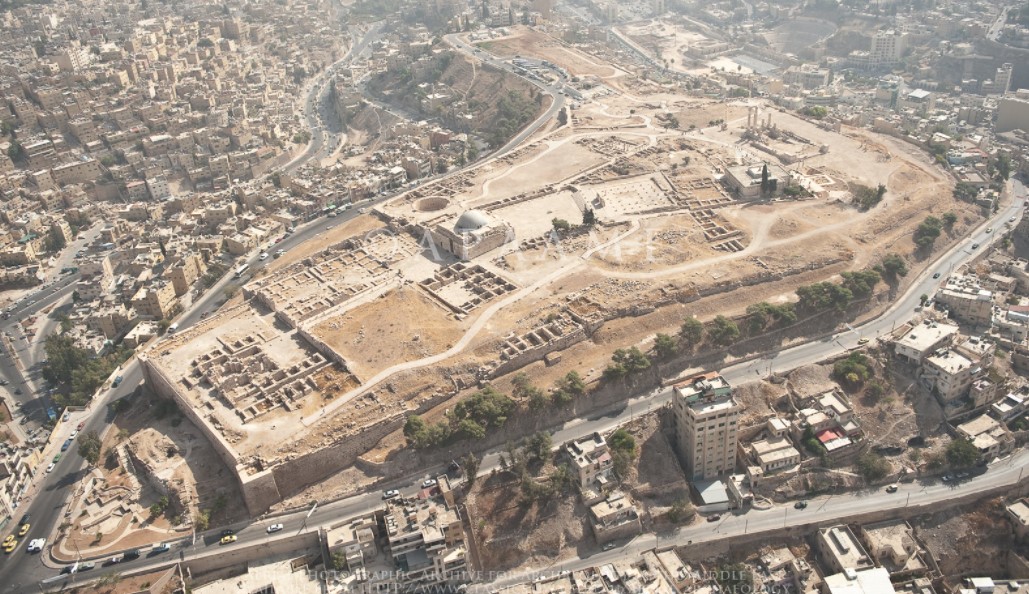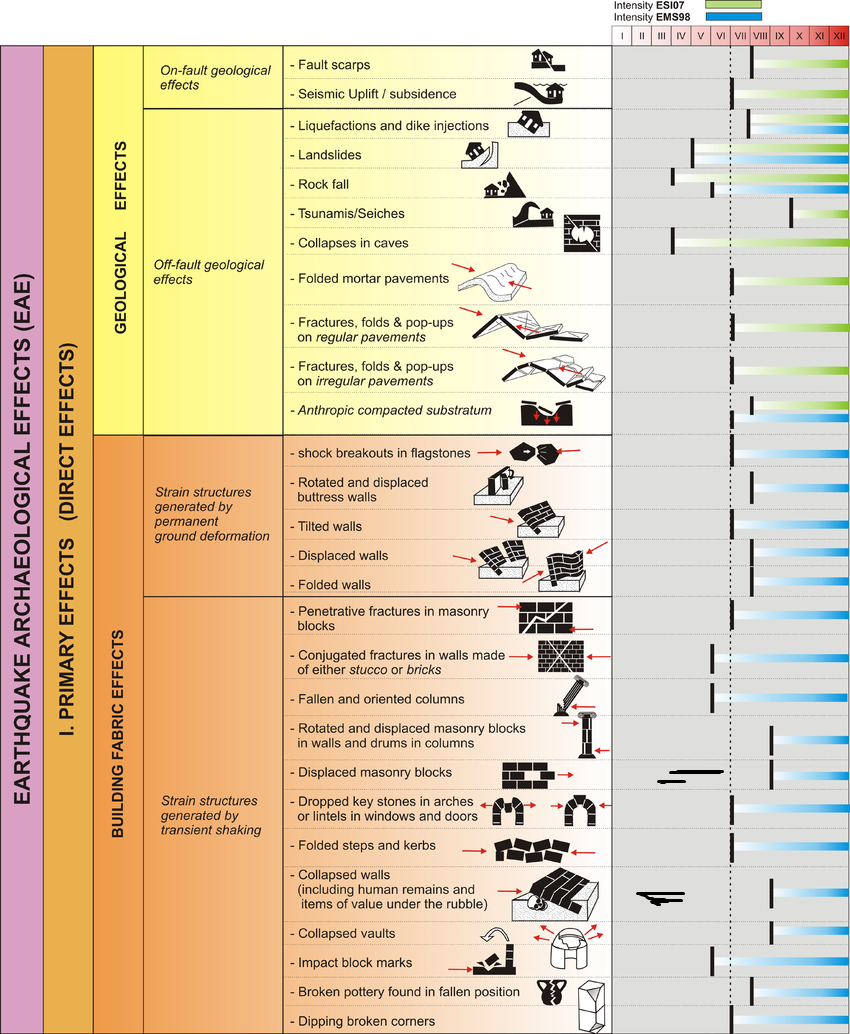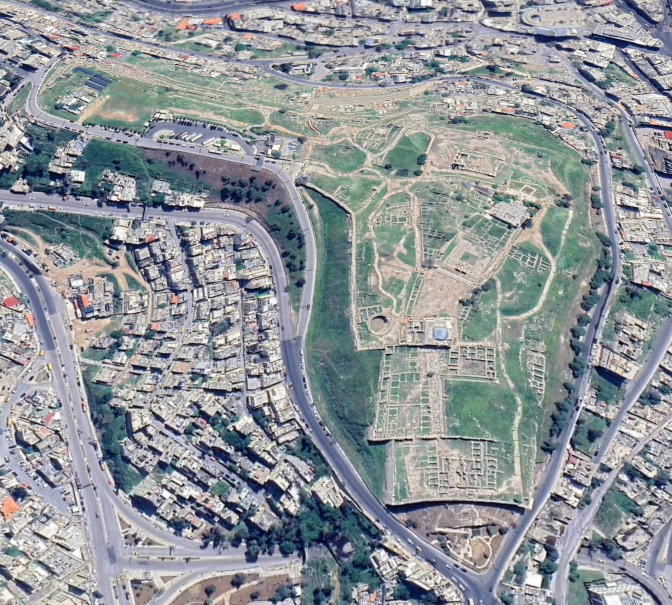Amman Citadel - Frankish Castle (aka Ayyubid Tower aka Tower B)
 Aerial Photograph of the Citadel in Amman
Aerial Photograph of the Citadel in AmmanAPAAME CC BY-NC-ND 2.0
| Transliterated Name | Language | Name |
|---|---|---|
| Frankish Castle | English | |
| Ayyubid Tower | English | |
| Tower B | English | |
- from Chat GPT 4o, 21 June 2025
Built of large, roughly dressed stones, the tower is rectangular in plan and is part of a wider phase of military reoccupation and construction on the Amman Citadel during the Ayyubid period, following the decline of Crusader control in Transjordan. Archaeological evidence suggests that the tower may have been part of a short-lived fortification effort, possibly linked to Saladin's campaigns or local governors seeking to secure the citadel. While modest in scale, its survival has made it an important feature for dating later phases of medieval activity on the site.
- from Amman - Introduction - click link to open new tab
- Area Plan of the Citadel
in Amman from maps-amman.com

 Amman Citadel
Amman Citadel
JW: Umayyad Palace at top of map
from maps-amman.com/amman-citadel-map
- Area Plan of the Citadel
in Amman from maps-amman.com

 Amman Citadel
Amman Citadel
JW: Umayyad Palace at top of map
from maps-amman.com/amman-citadel-map
- Ayyubid Tower at Amman Citadel
(Sinabaldi (2014) says it may have originally been a Crusader Tower) - photo by JW

 Ayyubid Tower at Amman Citadel
Ayyubid Tower at Amman Citadel
Photo by Jefferson Williams - 19 June 2025 - Ayyubid Tower at Amman Citadel
with explanation (Sinabaldi (2014) says it may have originally been a Crusader Tower) - photo by JW

 Ayyubid Tower at Amman Citadel
Ayyubid Tower at Amman Citadel
Photo by Jefferson Williams - 19 June 2025
- Ayyubid Tower at Amman Citadel
(Sinabaldi (2014) says it may have originally been a Crusader Tower) - photo by JW

 Ayyubid Tower at Amman Citadel
Ayyubid Tower at Amman Citadel
Photo by Jefferson Williams - 19 June 2025 - Ayyubid Tower at Amman Citadel
with explanation (Sinabaldi (2014) says it may have originally been a Crusader Tower) - photo by JW

 Ayyubid Tower at Amman Citadel
Ayyubid Tower at Amman Citadel
Photo by Jefferson Williams - 19 June 2025
Sinibaldi (2014:62) reports the following:
One of the Frankish castles held by Philip of Milly in 1161 and by the Templars in 1166 was in Amman,321 (and not in Ma‘an), but it is still not safely identified with material remains. A likely site would be the Citadel. However, the only surviving medieval fortified structure in the citadel, tower B, has been interpreted as Ayyubid on the basis of a coin dated 1190-91, used as a terminus post quem.322 Rescue excavations by Crystal-M. Bennett between 1975 and 1979 exposed the last phases of occupation at the site, whose abandonment has been interpreted as caused by an earthquake. Areas B, C and D, which were abandoned after the collapse, yielded similar pottery in the collapse level (level III)323 to suggest that all these areas were affected by the same event which caused the abandonment; the inhabitants did apparently not have the resources to reconstruct the area. The possible earthquake post-dated 1021 A.D., a date offered by a coin in the stratigraphy; Northedge proposes that the most likely earthquake affecting this situation was the one that occurred in AD 1068.324Sinibaldi (2014:240-241) added:
However, it cannot be excluded that the earthquake occurred later,325 and in fact this possibility may be supported by the pottery found in level III.326 Possible earthquakes in the 12th /13th centuries affecting Amman include those of 1139, 1170,1202, 1212, 1293, 1312, one of the most intense at that time being the one of 20 May 1202, which affected for example the castle of Jacob’s Ford (Vadum Iacob, le Chastelez) in the Jordan Valley; any of these, however, could have equally affected the citadel.327Footnotes321 See chapter 2.
322 Northedge et al. 1992, 113-114.
323 See appendix A
324 Northedge et al. 1992, 159-161.
325 Personal communication by Alastair Northedge.
326 See appendix b.
327 Agnon 2014 and personal communication by Agnon.
3. Pottery from other areas of Transjordan
Amman
Several examples of cooking pots from level III (the collapse that caused the abandonment of the site) at the Amman citadel have similarities with the 12th-13th century type well recorded in Israel as being produced in Beirut, although affinities are in particular with the earlier 12th-century type.1126 Similarities to these earlier variations occur in several examples,1127 although some of these cooking pots examples are certainly earlier than the Crusader period.1128 It has been observed not only that the early (12th century) type is globular, thin-walled and with an out-turned or straight rim (as opposed to the later type, thick-walled and deep in form), but also that an evolution observable in the 12th century is that at this moment the handles become more pulled up and narrower.1129
A cooking pot from group 8, building 1 in particular clearly belongs to this type, whose dating covers the second half of the 12th century and the first half of the 13th century.1130 The hypothesis of an earthquake was supported in particular by the recovery of this object, which judging from its position and almost perfect preservation, apparently fell from a cupboard or niche.1131 The cooking pot has an applied indented band, which is a very common element of this type,1132 a straight rim and glaze on the interior. The same phase includes types which have a very long duration and were in use in the 12th century, such as the large bowls with thumb-indented bands and comb decorations that are attested for the 12th century and later.1133
Unfortunately, the chronological separation between the late Fatimid and the early Crusader periods for this type is difficult, as the variations throughout these periods seem to be very minor.1134 A problem in isolating pottery of the 12th century is the fact that 11th-century pottery is not well known especially in Jordan, both for this specific type and in general. However, the possible evidence of 12th-century pottery in this specific context allows for an hypothesis that if the citadel was seriously damaged by an earthquake, it was during the 12th century or later, although probably not much earlier than around mid-century.
It is interesting that handmade pottery is almost absent in the assemblage of level III, and seems to appear only in the Ayyubid phases, dated by coins to the late 12th century-early 13th century.1135 There appears to be a gap between the abandonment and the reoccupation of the site, during the 11th/12th century; the gap cannot however be so long to justify this sudden introduction of handmade pottery. As it is well known, handmade pottery is already present in the 12th century in Transjordan. It is possible, therefore, that the presence of handmade pottery reflects rather the different function of settlement rather than chronology, i.e. it could have been more open to the import of ceramic products during the Crusader period, while after it, the site may have only attracted local pottery. However, it can also be noticed that no stratified glazed imports of the 12th century have been found.Footnotes1126 Avissar and Stern 2005, type II.2.1.1., II.2.1.2. and II.2.1.2.
1127 Northedge 1992, Fig. 151.2-3 (cfr. Avissar and Stern 2005, 91, type II.2.1.2., fig. 39.2); Northedge 1992, fig. 141.2 (cfr. Avissar and Stern 2005, 92, type II.2.1.3. , fig. 39.5.);Stern 2012, 41, pl. 4.15. 10, 12); (cfr. Avissar and Stern 2005, fig. 39.4-6).
1128 Northedge 1992, fig. 137. 5-6. I thank Edna Stern for providing this comment personally.
1129 Avissar and Stern 2005, 91.
1130 Northedge 1984, fig. 77.1 (cf. Avissar and Stern 2005, fig. 39.4-6, type II.2.1.3).
1131 Northedge 1992, 159.
1132 Stern 2012, 41, pl. 4.15. 10, 12.
1133 Avissar and Stern 2005, 84-85, fig. 36.2, type II.1.2.1.
1134 Stern 2012, 44.
1135 Northedge 1984, 281.
- from Chat GPT 5, 18 September 2025
- from Sinibaldi (2014)
Stratigraphic evidence shows that the destruction **post-dated 1021 CE**, the date of a coin found in situ. Alastair Northedge suggested that the most likely candidate was the **1068 CE earthquake**, which caused widespread damage in Palestine and Transjordan. However, later earthquakes cannot be excluded. Pottery in Level III may support a later date, and Sinibaldi notes that several events in the 12th–13th centuries (1139, 1170, 1202, 1212, 1293, 1312) could have equally produced the observed destruction.
Among these, the **20 May 1202 CE earthquake** is highlighted as especially intense, having devastated sites such as the Crusader castle of Jacob’s Ford (Vadum Iacob) in the Jordan Valley, and it may also have affected Amman. Thus, while the **1068 CE quake remains the strongest candidate**, later events, particularly **1202 CE**, cannot be excluded.
| Effect | Location | Image (s) | Comments |
|---|---|---|---|
|
Frankish Castle aka Ayyubid Tower
 Amman Citadel
Amman CitadelJW: Umayyad Palace at top of map from maps-amman.com/amman-citadel-map |

 Ayyubid Tower at Amman Citadel
Ayyubid Tower at Amman CitadelPhoto by Jefferson Williams - 19 June 2025 
 Ayyubid Tower at Amman Citadel
Ayyubid Tower at Amman CitadelPhoto by Jefferson Williams - 19 June 2025 |
|
- Earthquake Archeological Effects chart
of Rodríguez-Pascua et al (2013: 221-224)

 Earthquake Archeological Effects (EAE)
Earthquake Archeological Effects (EAE)
Rodríguez-Pascua et al (2013: 221-224)
| Effect | Location | Image (s) | Comments | Intensity |
|---|---|---|---|---|
|
Frankish Castle aka Ayyubid Tower
 Amman Citadel
Amman CitadelJW: Umayyad Palace at top of map from maps-amman.com/amman-citadel-map |

 Ayyubid Tower at Amman Citadel
Ayyubid Tower at Amman CitadelPhoto by Jefferson Williams - 19 June 2025 
 Ayyubid Tower at Amman Citadel
Ayyubid Tower at Amman CitadelPhoto by Jefferson Williams - 19 June 2025 |
|
|
Northedge, A., et al.:
1992 Studies on Roman and Islamic Amman. The Excavations of Mrs C.-M.
Bennett and Other investigations, British Academy Monographs in
Archaeology, 3 (Oxford: Oxford University Press for the British Institute
at Amman for Archaeology and History).
Northedge, A., et al.:
1992 Studies on Roman and Islamic Amman. The Excavations of Mrs C.-M.
Bennett and Other investigations, British Academy Monographs in
Archaeology, 3 (Oxford: Oxford University Press for the British Institute
at Amman for Archaeology and History).
